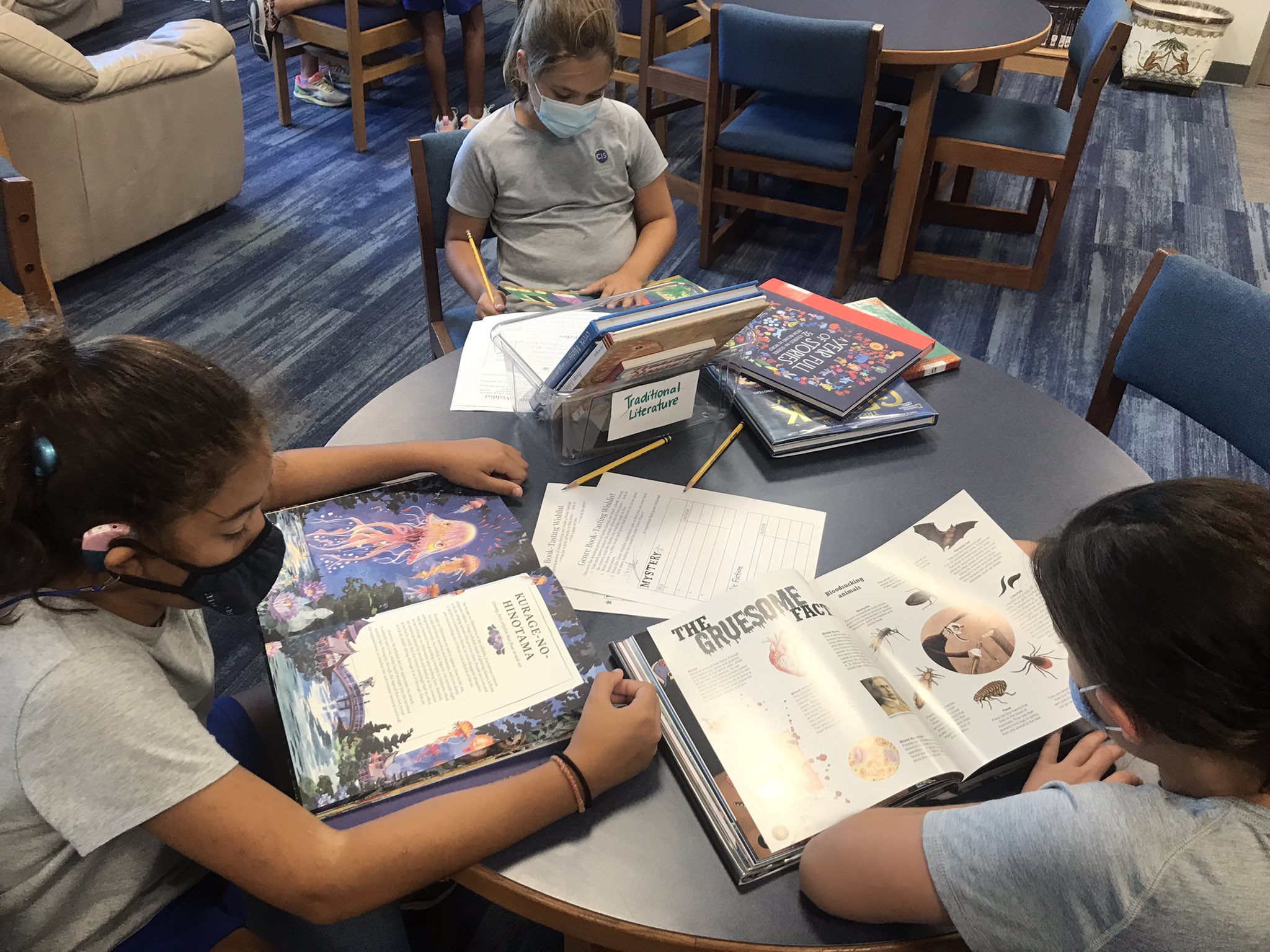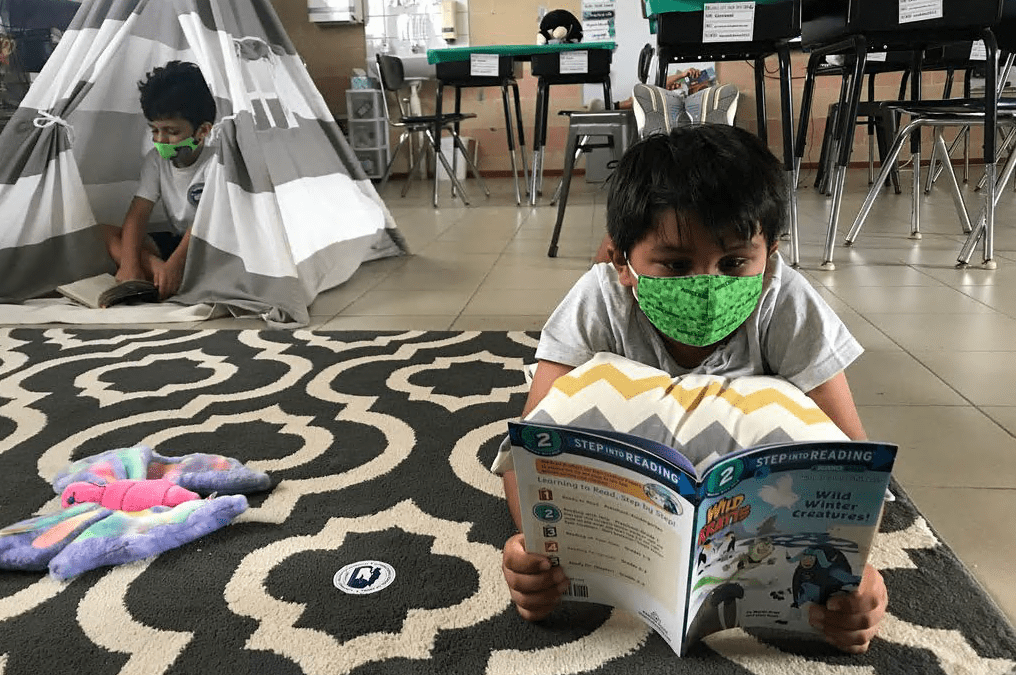Fostering a Love of Literacy with Growing Readers
By Laura Benson, ISS Director of Curriculum and Development

One of the greatest joys of my work life over the last months (and over the last nine years, too) has been working with the dedicated educators of Riffa Views International School in Bahrain. Seeking to expand literacy bridges between home and school, Riffa Views have embarked on a variety of reading initiatives with their community.
As part of these efforts, I have been meeting with Riffa Views parents, caregivers, teachers and administrators over the last months in Sunday workshops. Our studies have focused on supporting growing readers, and we have been so fortunate to gain the partnership and friendship of RVIS parents and educators from around the world.
Immersed in these vital conversations with parents and caregivers recently and over the last forty-three years in my work as an educator, one question is asked time and time again. It is one that I often hear in professional exchanges, too: How can we help children want to read? Variations of this earnest question include: How do I motivate my child/my students to read? What should I do when my kids don’t like to read or won’t read?
Be a visible reader
First and foremost, be a reader yourself and let your students and your own children see you reading. I share this seemingly obvious advice from research I conducted about 35 years ago now. In a study of hundreds of children including interviewing our own students, many of them, if not most, said that their parents did not read. This became increasingly mystifying because I knew a good number of the parents of our community, knew they were readers and, in fact, was in a book club with a many of them, too.
Digging into the mystery, we realized that the children of our school community were never seeing us read because we saved our reading for when they were asleep or not with us.
From these insights, we began making sure that we read in front of our children and students. In readers’ workshops and our literacy classes, reading alongside our students became vital daily rituals. In our homes, we devoted time each night or at least once a week for family reading time. With everybody huddled together on couches in our homes and on clusters of pillows in our classrooms, all the kids saw that we valued reading because they were witnessing us doing it. When reading becomes a shared activity in our homes as it is in our classrooms, children are naturally drawn to texts.
Give voice to internal dialogue
A next responsive step is to think of reading as an apprenticeship. Talk to children about not only what you are reading (which they love hearing) but also share why and how you are reading. Whether text messages or emails, novels or training manuals, poems or newspaper passages, paint rich portraits of what it means to live a literature life with the children in your life.
Go public with your ways of understanding, including needing to reread and problem solve texts which are not fun or easy to read (Think tax manuals or insurance form directions – always drudgery for me!). Watching a reader does help to convey its value and importance to observers. But reading is not a great demonstrator sport for young growing readers in knowing how to create and nurture understanding themselves.
So, give voice and language to your internal dialogue. Describe how you work to understand the texts you read with thinking self-talk such as “I wonder…” and “I bet…because…” along with “This seems very important because…” and “Now I know…” and “This reminds me of…”
Sharing how you talk to yourself before, during and after you read opens up the invisible world of the brain in vivid and inviting ways for all children of all ages.

So many books, we stumble over them
As part of helping children become motivated readers who choose literacy, give the children in your life nimble and easy access to books. Keep books in every room of your home, in your car, and in your carry-on luggage when you travel. Fill up your classroom libraries with books which reflect the children’s passions and wonders.
Critically important for our home libraries and classroom text collections, ensure that children see themselves in books racially, ethnically, and culturally. Give them rich and inviting opportunities to learn about people they see as unlike themselves, along with authors who look like them and writers who take them to new places in their thinking and learning.
As Robert Frost advised, surround youngsters with so many books they stumble over them. Make sure that their reading diets nurture their compassion for others while growing their confidence as readers and thinkers.
Growing young readers’ voices through choice
Along with access, tap into the vital power and energy of choice. We all like to read from our own choices, purposes, questions, needs and delights. Choice absolutely grows children’s voice as readers and learners. As often as possible, take your child or students to the school library, public library and bookstores. Help children get to know and fall in love with favorite authors and genres. And don’t worry if your children or students read one genre or author “too much.” The main thing right now as children are growing is that they do gain time reading.
Set students up for meaningful summer reading and further their independent reading by introducing them to books in a series and connecting them to favorite authors. Just as we love binge-watching Netflix, books in a series are great fun and trigger fluency and deeper comprehension with familiar characters, settings, and/or cadence. Book binges for the win!
Reading aloud
A meaningful way to launch students into reading books is a series and finding favorite authors are from our read alouds. What we read to our students become launching pads for their further independent reading. Marinate your students and children in read alouds. Read to your children until they leave home for college or work. No one is too old or tires of being read to, as evidenced by the huge market of audio books sales for adults.
Relatedly, another earth-moving way to help children find their reader voice and hearts are audio books. Recorded books give all of us easy entry and passage to the world of reading. Almost everyone loves to be read to and can name a favorite teacher because they read to us when we were children. Audio books give children language, often exposing kids to vital academic vocabulary. Audio books fill up our ears and brains with knowledge as well as rich words and new worlds. Every student who told me that they did not like to read was magically and gorgeously transformed by recorded books. It’s really just about impossible to not fall in love with reading when given the opportunity to dwell in audio books, especially because they literally open up the whole world to all of us.
As an added asset, the connection of audio books to technology and devices make them even more attractive and generally more accessible for children. We live in a time with terrific online book apps and vast virtual libraries. In our roles as teachers and/or parents, make sure the children in your life have easy and constant access to audio books. These are the literacy garden for so many growing readers.
Book clubs
From their choices as readers, encourage the children in your life – your own or your students – to create their own book clubs. My son Tim and I started a book club when he was in first grade. The first book we read together with invited friends was Lily’s Purple Plastic Purse by Kevin Henkes.
Our child-parent book club was a delightful part of our lives until the kids’ early years of high school when schedules became a bit too full for continuing our book club meetings.
But, as parents, all those years together in books gave us constant opportunities to talk with our children as book-mates and friends about a variety of subjects, topics and questions all of which were often much more comfortable to address through the characters and stories of the books we read together.
Reading as service
Lastly, if you are facing a situation where your child or students really don’t like to read yet, turn reading into a service project. When reading becomes a way to help another person, even kids who don’t like to read (or say they don’t right now) rise up to the situation compassionately and earnestly.
In schools like Riffa Views International School and so many ISS schools around the globe, our older students read to younger students. Older student reading friends become mentors and tutors for children even a bit younger than themselves and all the kids adore these collaborations. These exchanges are part of the school culture and, through these, we witness huge shifts in how children view themselves as proficient readers and beloved community members.
Time spent together in books helps children who do not yet see themselves as readers gain vital practice and often leads them to seeing what they can do as readers. These are huge insights because children frequently focus on what they cannot do rather than what they can do now. These service learning reading experiences become essential game- changers for kids moving from not wanting to read to seeing reading as personally purposeful and positive.
Variations of these edifying reading service projects include engaging children in reading to animals in rescue shelters, reading to or with seniors in a local care home and/or recording themselves reading a favorite book to their share passion and purposes for reading and, in doing so, support peers and/or younger students with online learning, too. Here in Colorado, I volunteer for a network of animal shelters where the children read to horses, dogs, and/or cats in their Tales for Tails program. The kids grow their fluency and empathy with these crucial practice sessions which end up not feeling like practice at all. If your child or students have not yet found joy in their own reading, then reading to others may be the literacy journey that helps them find their way as a reader.
A shared passion
As we approach upcoming seasonal breaks from school and work to set students up for meaningful independent reading practice, I hope these time-tested reading growth experiences from my own life will generate ideas for how you can support your developing readers. So much of being motivated to read comes from living with others who share their passion, tangles, and triumphs as readers themselves.
Happy reading, and happy sharing!
You can follow Laura at @LBopenbook.
This article was originally published in the April 2022 edition of ISS Newslinks.

